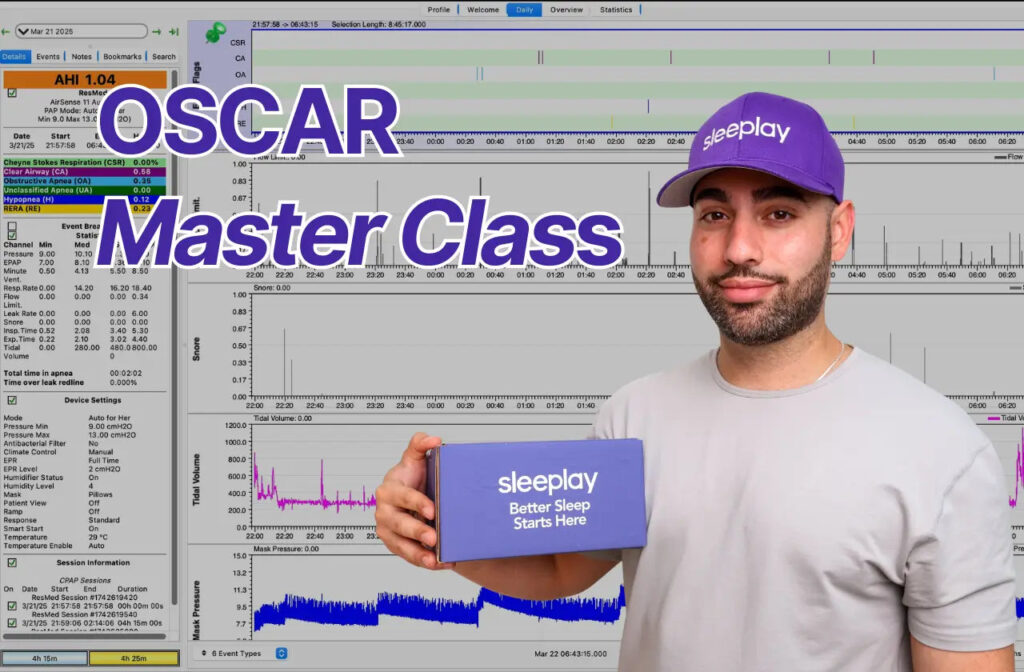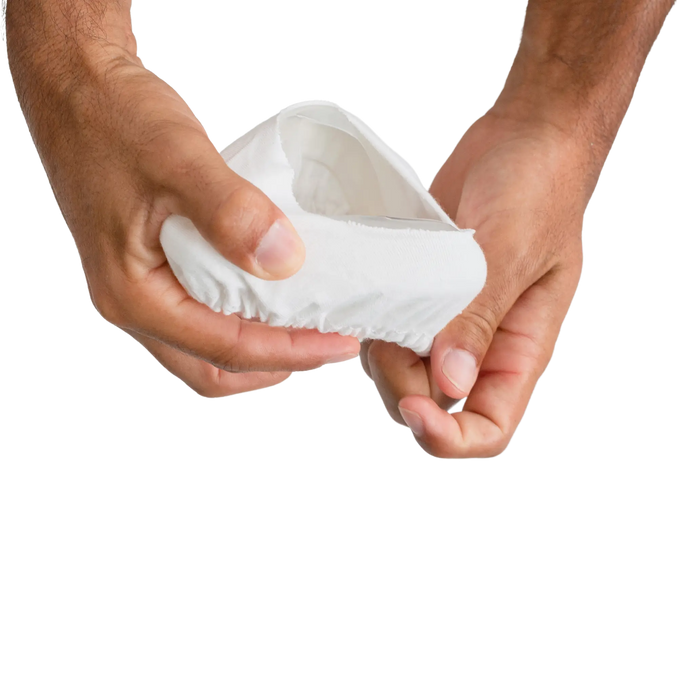AHI, Leaks & Strain – Sleeplay

OSCAR reveals AHI, leak, move, and strain so you’ll be able to spot widespread remedy points at a look. It’s normal to surprise what defines a “good” AHI, what counts as a regarding masks leak, or why your strain graph all of the sudden spikes in the course of the evening. This information teaches the proper studying order (Overview → AHI Occasions → Leak → Movement → Strain), gives fast checks, and affords tables that can assist you interpret widespread patterns.
When you can study extra about what your AHI rating means, the standard aim for handled adults is to hold the AHI < 5. It is usually essential to manage leaks, as “massive” leaks could make your remedy knowledge much less dependable and will fragment your sleep. Work together with your clinician earlier than altering settings.
What Is OSCAR and How Does It Assist You Observe CPAP Knowledge?
OSCAR (Open Supply CPAP Evaluation Reporter) is free software program that helps you see precisely what your CPAP machine is doing when you sleep. It converts the uncooked knowledge out of your machine’s SD card into visible charts. In line with OSCAR, trendy CPAP gadgets document detailed metrics akin to utilization hours, Apnea-Hypopnea Index (AHI), leak charges, airflow (move charge), and delivered strain. This permits each sufferers and clinicians to overview remedy high quality, spot potential points like leaks, and visualize respiratory patterns all the way down to a breath-by-breath stage.
The software program presents this knowledge in two fundamental views. The “Overview” tab summarizes your long-term tendencies, displaying issues like utilization and common AHI over weeks or months. The “Each day” view gives the detailed graphs for a single evening, together with AHI Occasions, Leak Fee, Movement Fee, and Strain, all aligned by timestamp. In later sections of this weblog, we’ll clarify how you can interpret AHI, leak charges, move patterns, and strain modifications intimately, beginning with AHI ranges and which meanss.
Here’s a fast abstract of the principle knowledge factors OSCAR shows:
|
Metric in OSCAR |
What it Represents |
|
Utilization Hours |
Whole time the machine was working every evening |
|
AHI Occasions |
Depend of apneas + hypopneas per hour |
|
Leak Fee |
Unintentional air escaping from the masks or mouth |
|
Movement Fee |
Form of every breath (inhalation/exhalation sample) |
|
Strain |
Delivered strain and automated changes over time |
Learn how to Open and Learn Your OSCAR Charts Step by Step
OSCAR organizes your nightly CPAP knowledge into graphs that should be aligned accurately for a significant overview. Earlier than you begin decoding metrics like AHI or leaks, you will need to first discover ways to open and synchronize your charts to learn them within the correct order. In line with OSCAR, knowledge from suitable CPAP gadgets could be imported by means of the SD card for a full nightly report. When you’re new to remedy, see our CPAP ideas for freshmen for setup fundamentals.
Right here is the essential course of for navigating your knowledge:
-
Import your knowledge. Insert your SD card into the pc and open the OSCAR software program. Choose your system profile and select the “Each day View” to see your full nightly report.
-
Align the time scales. Be certain the time axis throughout all charts matches. This ensures that AHI Occasions, Leak Fee, Movement Fee, and Strain are synchronized so you’ll be able to see what occurred on the similar second.
-
Observe the studying order. Start on the “Overview” tab for averages. Then, within the “Each day” view, transfer by means of AHI Occasions, Leak Fee, Movement Fee, and at last Strain. That is the order we are going to use all through the remainder of this information.
-
Zoom into uncommon durations. Deal with any spikes, excessive leaks, or respiratory irregularities. You may zoom into shorter time home windows to look at precisely when these occasions occurred in the course of the evening.
-
Search for repeating patterns. Examine a number of nights of knowledge. This helps you see if issues, like a selected kind of masks leak, are taking place persistently earlier than assuming one thing is improper together with your setup.
Widespread Errors to Keep away from
Listed here are some widespread errors to keep away from while you first begin:
-
Judging your remedy from one single evening as an alternative of reviewing patterns over time.
-
Ignoring the leak knowledge. As highlighted by the American Thoracic Society, massive leaks could make occasion knowledge like AHI or strain much less correct and disturb sleep high quality.
-
Evaluating OSCAR outcomes between completely different CPAP machine manufacturers with out noting that chart layouts or how they outline a “massive leak” would possibly fluctuate.
-
Altering your prescribed strain settings with out scientific steering.
-
Misinterpreting quick, transient spikes or remoted occasions as constant remedy points.
For extra navigation ideas, the OSCAR neighborhood useful resource “OSCAR — The Information” out there on ApneaBoard gives extra setup visuals and FAQs.
What Does AHI Imply on OSCAR and What Numbers Are Regular?
The Apnea-Hypopnea Index (AHI) represents the common variety of apneas (pauses in respiratory) and hypopneas (shallow respiratory) you expertise per hour of sleep. Most clinicians and sleep specialists goal an AHI < 5 for adults receiving efficient CPAP remedy, as famous by the Cleveland Clinic. OSCAR shows this metric for each evening, serving to you and your physician monitor how properly the remedy is controlling these respiratory occasions. For a deeper breakdown of AHI scoring and why it issues for sleep high quality, see our AHI Rating Information.
Listed here are the usual scientific classifications for AHI:
|
AHI Vary (occasions/hr) |
Scientific Classification |
|
< 5 |
Regular (well-treated on CPAP) |
|
5 – 15 |
Delicate Sleep Apnea |
|
15 – 30 |
Average Sleep Apnea |
|
> 30 |
Extreme Sleep Apnea |
Fast Word: Actual classes can fluctuate barely between clinics and research.
It is usually essential to know that AHI values typically change from evening to nighttime, even in well-controlled sufferers. As famous in a dialogue by CPAP producer ResMed, small will increase (for instance, from 1.5 to 4.0) are regular. This variation could be attributable to modifications in sleep place, the combo of sleep phases, and even nasal congestion. You need to focus in your multi-night tendencies in OSCAR slightly than worrying about remoted spikes. A barely increased AHI for one evening doesn’t robotically imply your remedy is failing; it simply alerts a must verify for constant patterns.
The accuracy of your AHI quantity will also be affected by masks leaks or the particular algorithms your CPAP machine makes use of. As an illustration, a 2025 research by Dr. Celia Vidal et al. revealed in Respiratory Analysis discovered that some CPAP gadgets exclude occasions throughout main leak durations. This may make the reported AHI seem decrease than the true variety of respiratory interruptions you skilled. This implies you need to all the time interpret your AHI charts alongside your leak charge graphs to make sure the info is dependable. The following part of this information explains how leaks can alter accuracy and luxury.
How Do Masks Leaks Have an effect on AHI Accuracy in OSCAR?
Massive leaks can distort your AHI readings and fragment your sleep, making your remedy knowledge in OSCAR unreliable. Whereas OSCAR graphs will nonetheless present the leak exercise, excessive or sustained leak charges cut back the accuracy of how the machine detects apneas and hypopneas. As proven in a scientific case by the American Thoracic Society, massive leaks may cause misleadingly low AHI readings even whereas signs of poor sleep proceed. Controlling leaks is crucial earlier than you think about adjusting strain or altering your masks kind.
It helps to know there are two kinds of leaks. Intentional leaks are regular; that is the built-in venting in your masks designed to launch exhaled CO₂. Unintentional leaks are the issue. That is air escaping from a poor masks seal, an open mouth, or worn-out masks parts. Every CPAP model makes use of its personal “massive leak” threshold. As an illustration, ResMed gadgets typically flag sustained leaks round 24 L/min as a warning, however you need to all the time confirm these values within the context of your particular machine.
Massive leaks can considerably cut back occasion detection accuracy, resulting in an underreported AHI in OSCAR. This occurs as a result of the machine can not correctly distinguish actual respiratory occasions when an excessive amount of air is escaping the circuit. That very same American Thoracic Society case confirms that this knowledge inaccuracy occurs throughout main leaks. Leaks additionally have an effect on your bodily consolation. In line with Mayo Clinic Well being System, leaks that blow air towards the eyes may cause irritation and dryness, signaling the necessity to refit or alter the masks. Leaks don’t simply disrupt knowledge; in addition they contribute to poor sleep high quality and frustration with remedy.
Listed here are widespread signs and warning indicators that leaks could also be a problem:
-
Dry mouth or throat upon waking
-
Hissing or whistling sounds close to the masks or tubing
-
Air blowing towards your eyes
-
Waking up often in the course of the evening and not using a clear trigger
-
OSCAR “Leak Fee” chart displaying prolonged peaks properly above the baseline
These signs point out that leaks could also be affecting each your consolation and knowledge reliability.
The excellent news is that small modifications can typically reduce leaks earlier than assuming it’s a strain or masks subject. See our detailed information on how you can cut back CPAP masks leaks for sensible changes based mostly in your masks kind. You need to use merchandise from our Masks Liners Assortment to assist enhance the seal and cut back pores and skin irritation. If the leaks are attributable to your mouth opening (mouth respiratory), making use of specialised mouth tape like Hush Strips, CPAPTape, or REMSleep Professional Cloth can resolve the difficulty. Lastly, all the time keep seal integrity by means of correct cleansing utilizing instruments just like the Snugell Hose Brush Set and the CPAP Cleansing Wipes Assortment. Correct hygiene helps forestall facial oils and residue buildup, which might weaken masks seals and worsen leaks over time.
Learn how to Learn Movement Fee Charts and Spot Respiration Points
The Movement Fee chart in OSCAR reveals the exact form, frequency, and rhythm of each breath you are taking. Typically, rounded and easy waves characterize steady, unobstructed respiratory. In distinction, flattened peaks or irregular, jagged shapes can recommend move limitation, nasal resistance, or transient arousals that disturb your respiratory. You will need to know that these patterns can happen naturally all through the evening, particularly throughout REM sleep or while you change your sleeping place. In line with OSCAR, move charge knowledge gives a breath-by-breath view of airflow that may reveal delicate patterns in respiratory stability.

Right here is an easy information to widespread move shapes:
|
Movement Form in OSCAR |
What It Signifies |
|
Rounded, easy wave |
Regular, regular respiratory with balanced inhale and exhale |
|
Flattened inspiratory peak |
Movement limitation (potential nasal resistance or airway narrowing) |
|
Sawtooth variability |
Fragmented respiratory or arousals disrupting rhythm |
|
Abrupt move drop or irregular gaps |
Short-term airflow instability (must be checked alongside the AHI chart) |
Movement limitations could not all the time present as apnea occasions, however can nonetheless cut back sleep high quality if persistent.
Minor modifications within the waveform can typically be attributable to easy points like nasal congestion, allergic reactions, low humidity in your room, or sleeping in a supine (in your again) place. Earlier than assuming a significant remedy subject, attempt these easy, protected checks to enhance airflow consistency:
-
Guarantee your nasal passages are clear.
-
Confirm your humidifier settings are sufficient for the room’s air.
-
Keep away from tucking your chin tightly or having poor neck alignment whereas sleeping.
As famous by Mayo Clinic Well being System, even small masks match or strain points can alter consolation and respiratory rhythm throughout sleep.
When you persistently see move limitations in your chart, it could relate to your masks match or the design of the nasal interface. Generally, switching to a light-weight, high-seal nasal masks can enhance airflow consolation and assist keep a extra constant move sample. For instance, the AirFit P10 Nasal Masks is right for steady, low-resistance respiratory. Equally, the F&P Evora Nasal Masks contains a light-weight design that helps constant airflow.
Why Does My CPAP Strain Hold Altering in OSCAR?
If you’re utilizing an Auto-CPAP (APAP) machine, the strain modifications as a result of it robotically adjusts its settings in actual time to answer respiratory irregularities. OSCAR graphs present these changes, which regularly seem as “spikes” or gradual climbs within the strain line all through the evening. You will need to perceive that the majority of those strain modifications are intentional and adaptive; they’re designed to maintain your airway open and will not be normally an indication of a machine fault. For a full overview of how these settings work, go to our CPAP strain settings information.
Listed here are the commonest causes of strain spikes in the course of the evening:
-
Movement limitations: When the machine senses your airflow is restricted (which you would possibly see as flattened peaks in your move charge chart), it briefly will increase strain to clear the obstruction.
-
Apnea or hypopnea occasions: If the machine detects a pause (apnea) or vital shallowing (hypopnea) in your respiratory, it can robotically elevate the strain to reopen the airway.
-
Masks leaks: Massive or fluctuating leaks can confuse the machine’s algorithm. It would misread the air loss as a respiratory occasion and lift the strain unnecessarily.
-
Positional apnea: Sleeping in your again (supine) may cause your airway to break down extra simply. The machine will reply by delivering repeated strain will increase to maintain it open.
-
Mouth opening or chin drop: This causes vital air loss from the mouth, triggering strain changes because the system tries to compensate for the misplaced quantity.
Brief-term strain will increase are regular and normally imply your Auto-CPAP is responding accurately to occasions. You need to solely be involved for those who see persistent, unstable strain swings, which can sign an unresolved underlying subject normally attributable to leaks or sleeping place. Earlier than contemplating setting changes, first overview your leak charge charts (as mentioned within the earlier part) and verify your sleeping place. A supportive sleep place might help cut back pointless strain modifications. A CPAP-specific pillow, such because the Greatest in Relaxation Reminiscence Foam CPAP Pillow with Cooling Gel, helps keep correct alignment and might forestall your masks from shifting and leaking while you sleep in your facet.
In case your AHI stays elevated in OSCAR even after you’ve gotten resolved masks leak and positional points, your remedy would possibly profit from a sensible, auto-adjusting system. In case your remedy knowledge continues to point out frequent occasions regardless of these changes, an Auto-Adjusting CPAP Machine can fine-tune the strain dynamically based mostly in your particular nightly wants.
What Widespread Patterns Imply in Your OSCAR Knowledge (Choice Information)
OSCAR’s charts are most useful while you search for patterns over time. A single odd evening is never a priority, however recurring tendencies can spotlight areas to verify. The desk beneath helps you interpret what these widespread patterns would possibly imply and what easy, protected checks you’ll be able to attempt. At all times overview persistent points together with your sleep specialist earlier than altering any prescribed settings.
|
What You See in OSCAR |
Probably Trigger |
First Issues to Attempt |
|
AHI stays >10 throughout a number of nights |
Strain could also be too low, or main leaks are inflicting inaccurate AHI readings. |
First, repair any leaks utilizing Masks Liners or light mouth tape, and clear your gear. If AHI stays excessive (the aim is <5 per the Cleveland Clinic), overview the info together with your clinician. Leaks may cause deceptive AHI counts (in accordance with the American Thoracic Society). |
|
Lengthy durations of “massive leak” |
Mouth opening throughout sleep or a poor masks seal. |
Attempt Masks Liners to enhance the seal, or light mouth tape like Hush Strips or REMSleep Professional Cloth. Examine your strap pressure (not too tight) and see in case your masks cushion is worn out. Leaks may cause eye irritation (Mayo Clinic) and disrupt remedy (American Thoracic Society). |
|
Flattened inspiratory peaks (Movement Fee) |
Movement limitation. This may be attributable to nasal resistance, allergic reactions, or airway narrowing. |
Enhance nasal airflow by managing congestion and checking your humidifier settings. Take into account a consistent-seal nasal masks just like the AirFit P10 or F&P Evora Nasal Masks for steady respiratory. |
|
Frequent strain spikes |
Positional apnea (widespread when sleeping on the again) or the machine is responding to leaks. |
Attempt sleeping in your facet. A CPAP Pillow might help keep alignment and forestall masks shift. Repair any leaks first, then talk about persistent spikes together with your clinician. |
|
Persistent dry mouth & noisy nights |
Mouth leaks and/or low humidity settings. |
Improve your humidifier setting one step at a time. Examine your hose for tiny leaks. Use Masks Liners or light mouth tape to seal leaks. Constant cleansing with a Snugell Hose Brush Set and CPAP Wipes additionally helps keep seal integrity. |
Keep in mind to overview these patterns over a number of nights slightly than reacting to a single anomaly. By no means change prescription strain settings by yourself. If patterns persist regardless of good masks match and cleansing, share your OSCAR studies together with your clinician for overview.
FAQs and Security Ideas for Studying Your CPAP Knowledge
1. What is an effective AHI quantity on OSCAR?
A “good” AHI on OSCAR is mostly thought of any quantity beneath 5 occasions per hour for a handled grownup. That is the usual remedy goal most clinicians goal for, as outlined by the Cleveland Clinic. Whereas it’s regular for this quantity to fluctuate barely from evening to nighttime, if it stays persistently excessive, it could be an indication of remedy points or inaccurate readings attributable to massive leaks. For an entire rationalization, see our AHI Rating Information.
2. Why does my AHI fluctuate from evening to nighttime?
Minor AHI fluctuations are fully regular and anticipated. Your AHI can simply change from 1.5 one evening to 4.0 the following based mostly on elements like your sleep place (sleeping in your again typically will increase occasions), nasal congestion, allergic reactions, or how a lot REM sleep you had. As famous by ResMed, this variability is ok. You need to monitor your multi-night averages to see the true development slightly than specializing in a single evening’s quantity.
3. How can I inform if leaks are affecting my OSCAR knowledge?
Examine your Leak Fee chart for lengthy, sustained durations of excessive leaks (typically flagged as “massive leaks” > 24 L/min on many ResMed gadgets). When leaks are this excessive, your machine can not precisely detect respiratory occasions, which might trigger your AHI to be falsely under-reported. Each the American Thoracic Society and Mayo Clinic verify that leaks disrupt remedy and knowledge accuracy. Utilizing Masks Liners or light mouth tape might help enhance seal stability.
4. What do flattened waveforms imply within the Movement Fee chart?
Flattened inspiratory peaks (the highest of your inhale breath) on the Movement Fee chart usually point out “move limitation.” This implies one thing is inflicting partial resistance or narrowing in your airway, typically from nasal congestion, allergic reactions, or your sleep posture. You may attempt enhancing your humidity settings to assist with congestion. Generally, a high-seal, low-profile nasal masks just like the AirFit P10 might help keep smoother airflow. When you see this sample persistently, you need to talk about it together with your clinician.
5. Why does my CPAP strain hold rising in the course of the evening?
In case you have an Auto-CPAP (APAP) machine, the strain is supposed to rise and fall. The machine’s algorithm robotically will increase strain in real-time to answer detected occasions like apneas, hypopneas, or move limitations. These “spikes” imply the machine is doing its job. You may study extra in our CPAP Strain Settings Information. If the spikes are fixed and associated to posture, utilizing a Greatest in Relaxation CPAP Pillow might help keep head and neck alignment to cut back these occasions.
6. How lengthy ought to I overview my OSCAR knowledge earlier than making modifications?
You need to monitor at the very least 7 to 14 nights of knowledge to establish constant tendencies. Reacting to a single dangerous evening is a typical mistake; you have to see if a problem (like excessive leaks or AHI spikes) is a persistent sample or only a one-time outlier. Most significantly, by no means change your prescribed strain settings your self. At all times export your studies and share them together with your clinician for overview earlier than making any changes to your remedy.
7. What’s the distinction between leaks, move limitations, and apneas in OSCAR?
These phrases describe three completely different occasions. A leak is solely air escaping the circuit (out of your masks or mouth). A move limitation is a change in your respiratory form (a flattened peak), indicating restricted airflow. An apnea is a respiratory occasion, or a partial or full cease in respiratory. This is the reason you need to learn the charts in sequence (AHI → Leak → Movement → Strain) to get the complete story, as we lined in our Learn how to Learn OSCAR Charts Step by Step.
8. Can cleansing have an effect on CPAP knowledge accuracy?
Sure. Facial oils, mud, and residue can construct up in your masks cushion, inflicting the seal to fail and resulting in leaks. Buildup in exhalation ports or connections may also intervene with how the machine senses airflow. Routine upkeep with instruments just like the Snugell CPAP Tube and Masks Cleansing Brush Set and CPAP Wipes ensures a constant, dependable seal and helps extra correct strain supply and OSCAR readings.
9. How can I export or share my OSCAR report with my clinician?
OSCAR has a built-in operate that means that you can export your Each day or Overview studies as PDFs for e-mail or add. For a sooner scientific overview, it’s useful to spotlight the principle tendencies you’re seeing, akin to common AHI, durations of excessive leak, and the strain graph. Yow will discover detailed directions for exporting on the OSCAR official web site.
10. When ought to I speak to my physician about OSCAR knowledge?
You need to contact your physician in case your AHI persistently stays above 10, when you have massive leaks that persist each evening regardless of changes, or if the strain swings really feel uncomfortable and wake you up. Even when your numbers look “good,” however you continue to really feel drained, it’s essential to share your studies. Remedy optimization, as referenced by scientific targets from the Cleveland Clinic, all the time includes skilled medical enter.
References:
-
Liobard, H., & Resmed. (2025, March 5). Why does my apnea–hypopnea index (AHI) change? Resmed. https://www.resmed.com/en-us/sleep-health/weblog/why-does-my-apnea-hypopnea-index-ahi-change/
-
OSCAR – Open Supply CPAP Evaluation reporter. (n.d.). https://www.sleepfiles.com/OSCAR
-
Skilled, C. C. M. (2025, July 25). Apnea-Hypopnea Index (AHI). Cleveland Clinic. https://my.clevelandclinic.org/well being/articles/apnea-hypopnea-index-ahi
-
Christopher Williams, M.D., (2022, July 21). Check your CPAP IQ. Mayo Clinic. https://www.mayoclinichealthsystem.org/hometown-health/speaking-of-health/test-your-cpap-iq
-
Two head scratchers: What’s inflicting the leak? (n.d.). https://www.thoracic.org/professionals/clinical-resources/sleep/sleep-fragments/whats-causing-the-leak.php
-
Vidal, C., Mallet, J., Skinner, S., Gilson, R., Gaubert, O., Prigent, A., Gagnadoux, F., Bourdin, A., Molinari, N., & Jaffuel, D. (2025). Considerations arising from the calculation of the apnea-hypopnea index throughout CPAP-telemonitoring of sufferers with obstructive sleep apnea. Respiratory Analysis, 26(1), 244. https://doi.org/10.1186/s12931-025-03324-4









